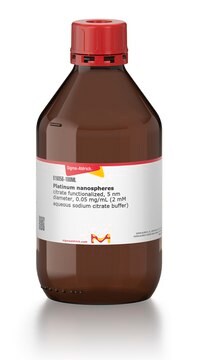771937
Platin
nanopowder, 200 nm particle size (SEM), 99.9% (metals basis)
Synonym(e):
Platinum black, Platinum element
About This Item
Empfohlene Produkte
Qualitätsniveau
Assay
99.9% (metals basis)
Form
nanopowder
Eignung der Reaktion
reagent type: catalyst
core: platinum
Widerstandsfähigkeit
10.6 μΩ-cm, 20°C
Partikelgröße
200 nm (SEM)
bp
3827 °C (lit.)
mp (Schmelzpunkt)
1772 °C (lit.)
Dichte
21.45 g/cm3 (lit.)
SMILES String
[Pt]
InChI
1S/Pt
InChIKey
BASFCYQUMIYNBI-UHFFFAOYSA-N
Allgemeine Beschreibung
Anwendung
Leistungsmerkmale und Vorteile
Signalwort
Danger
H-Sätze
Gefahreneinstufungen
Flam. Sol. 1
Lagerklassenschlüssel
4.1B - Flammable solid hazardous materials
WGK
nwg
Flammpunkt (°F)
Not applicable
Flammpunkt (°C)
Not applicable
Hier finden Sie alle aktuellen Versionen:
Analysenzertifikate (COA)
Die passende Version wird nicht angezeigt?
Wenn Sie eine bestimmte Version benötigen, können Sie anhand der Lot- oder Chargennummer nach einem spezifischen Zertifikat suchen.
Besitzen Sie dieses Produkt bereits?
In der Dokumentenbibliothek finden Sie die Dokumentation zu den Produkten, die Sie kürzlich erworben haben.
Kunden haben sich ebenfalls angesehen
Artikel
Professor Ebrahimi and Professor Robinson (Pennsylvania State University, USA) summarize recent advances in the synthesis of these 2D materials, resulting material properties, and related applications in biosensing of neurotransmitters, metabolites, proteins, nucleic acids, bacterial cells, and heavy metals.
Graphene is a unique two-dimensional (2D) structure of monolayer carbon atoms packed into a dense honeycomb crystal that has attracted great interest due to its diverse and fascinating properties.
Electronically, it behaves as a wide band gap (3.2 eV) semiconductor and exhibits memristor properties.2 Optically, TiO2 has high opacity with a very high refractive index3 (>2.4), and it exhibits strong absorbance in the UV range.
The production of hydrogen by catalytic water splitting is important for a wide range of industries including renewable energy petroleum refining and for the production of methanol and ammonia in the chemical industry.
Unser Team von Wissenschaftlern verfügt über Erfahrung in allen Forschungsbereichen einschließlich Life Science, Materialwissenschaften, chemischer Synthese, Chromatographie, Analytik und vielen mehr..
Setzen Sie sich mit dem technischen Dienst in Verbindung.





